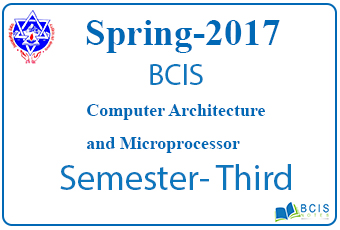
Pokhara University- Computer Architecture and Microprocessor
Level: Bachelor Semester – Spring Year : 2017
Programme: BCIS Full Marks: 100
Course: Computer Architecture and Microprocessor
Pass Marks: 45
Time : 3hrs.
Candidates are required to give their answers in their own words as far as practicable of Computer Architecture and Microprocessor. The figures in the margin indicate full marks.
Section “A”
Very Short Answer Questions
Attempt all the questions. 10×2
1. Differentiate microprocessor, micro-controller and microcomputer.
2. What is an opcode? What is the size of opcode, and an instruction of 8085 microprocessor?
3. Explain the working of CMP instruction with examples.
4. What is the specialty of Accumulator and HL pair over other register pairs?
5. What is the function of ALE? Explain what System Bus is?
6. Write down two merits and demerits of I/O mapped and memory mapped I/O.
7. What do you understand by Interrupt Service Routine (ISR)?
8. Differentiate between RISC and CISC architecture
9. What do you understand by interrupts? Mention three conditions required to get 8085 interrupted by I/O devices.
10. How is synchronous and asynchronous serial transmission different?
Section “B”
Descriptive Answer Questions
Attempt any six questions 6×10
11. With a neat diagram explain the architecture of 8085 needed for instruction execution.
12. What do you mean by addressing mode? Explain several types of addressing modes available in 8085, with an example of each.
13. How is instruction-cycle different to machine-cycle? List out the machine cycles of 8085 and explain them.
14. Assume that before the execution of any instruction we have (A) = 65 H, (B) = B2 H, (H) = F9 H, (L) = 50 H, CY flag = 1, and the content of memory location F950 H is 20H. What is the value of register A and the value of different flags after the execution of each of the following?
a) ADD L
b) ADC B
c) SUI 13 H
15. Explain the working principle of 8237 DMA controller.
16. Write an 8085-assembly language program to perform addition of N 1-byte numbers. N value is provided in location X. From location X+1, the numbers are stored. Store the result in location Y and Y+1. Also display the result in the address field.
17. Briefly explain ISA, PCI, AGP and USB interface standards.
18.Section “C”
Case Analysis (20)
1. Let us say we have a hypothetical multiplier chip with four registers (R0, R1, R2 and R3). Address pins A1 and A0 are used to select registers. Considering the chip connected as I/O mapped I/O, explain in detail the basic I/O writing a program segment.
2. Write down a flowchart for interrupt driven data transfer.
3. With a neat diagram explain the functional pin diagram of 8255.
4. Explain the mode 0, mode 1 and mode 2 operations of 8255 ports.
You may also like System Analysis and Design || Spring 2016 || Pokhara University

Leave a Reply